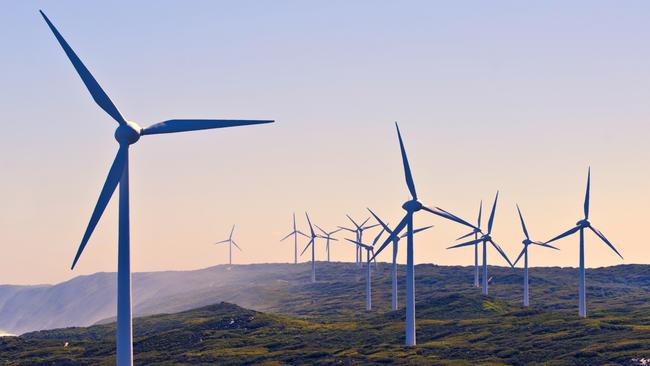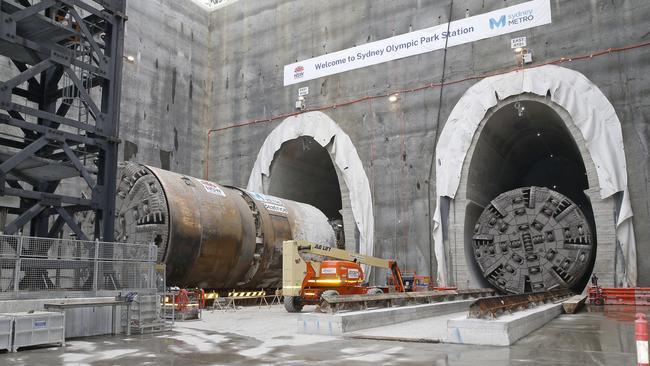Australia faces 197,000 infrastructure worker shortage as renewable energy projects rise
Australia is facing a shortage of nearly 200,000 workers to deliver the nation’s $213bn major infrastructure pipeline, with renewable energy projects set to increase six-fold in just four years.

Australia is facing a shortage of nearly 200,000 workers to deliver the nation’s $213bn major infrastructure pipeline, with renewable energy projects set to increase six-fold in just four years as governments prioritise the energy transition and housing crisis.
Infrastructure Australia’s latest market capacity report, to be released on Monday, reveals the transport boom has peaked and the focus is turning to green energy and new homes, as projects shift from the most populous states of NSW and Victoria to more regional areas in the Northern Territory and Queensland.
Amid warnings from former Liberal treasurer Peter Costello that Australia risks returning to the “middle of the pack” among developed countries as its envious economic position is erased and structural reform becomes non-existent, IA chief executive Adam Copp conceded the nation would not be able to fill the 197,000 extra worker places needed to deliver on major public infrastructure in the next five years.
Productivity that had stagnated in the construction sector for more than three decades and rising material costs were also challenging infrastructure delivery.
“Construction materials on average cost 30 per cent more than they did three years ago and with ongoing skills shortages we simply don’t have the people power we need to get the job done on time – our analysis shows 7 per cent of the pipeline, or $15bn of planned construction work, has been hampered by project delays,” Mr Copp said.
“There’s a number of things that governments can do. Obviously migration settings is part of that in the near term but there does need to be a real focus on the long-term sustainability of the skills coming through the construction sector.
“We need to better attract and train people to come work in the construction sector. Importantly, we also need to retain them when they get here.
“(There’s) a very low level of female participation in the sector – it’s about 14 per cent nationally, only about 2 per cent on site are women. Part of the reason for that is that it is an unattractive place to work for women and it’s an unattractive place to work for a lot of young people. So we see women and young people come into the sector and leave quite swiftly.”
Excessive working hours, minimal gender diversity and double the rate of stress and suicide in construction compared to the national average are said to be costing the economy about $8bn each year.
While there’s been a decade of record investment in major transport projects that has now decreased by $32bn to $126bn of the pipeline, building and utilities infrastructure, which is largely renewable energy projects and transmission, have grown to $71bn and $16bn respectively.

IA analysis for The Australian shows government and private investment in all utilities infrastructure (both small and major projects) will increase from $6.3bn in 2023-24 to $33.3bn in 2026-27.
Renewable energy projects make up $5.1bn (81 per cent) of the utilities spend in 2023-24 and grow to $29.5bn (89 per cent) in 2026-27.
The two biggest types of projects driving the six-fold increase are large-scale solar and wind farms, which make up 70 per cent of the pipeline.
“As this investment in renewable energy increases, both governments and the private sector should plan for the logistics and enabling infrastructure needed to support those projects,” Mr Copp said.
“Equipment such as wind turbine blades can measure up to 70m in length and 7m in diameter – we need to ensure we not only have the resources to deliver these projects but also the enabling infrastructure required to get the resources to where they are needed.
“It’s about the transmission as well, of course, but then it’s about making sure that we have the logistics chains in place to get this new renewable energy kit from the port through the logistics chain, the freight supply chain, down to the Renewable Energy Zone, and that means that there will need to be investments in the ports to make sure there’s appropriate staging areas to house this material.
“That we’re focused on upgrading the roads appropriately for the connections to the Renewable Energy Zone, that we’ve looked at the regulatory frameworks to make sure there’s an appropriate number of truck movements … that we’ve got the housing in place for the workers.”
As the type of projects is changing, so too are the projects locations, with pipelines in NSW and Victoria decreasing by a total $39bn as the NT’s and Queensland’s pipelines increase by $16bn.
Mr Copp said attracting workers to more regional areas was the greatest challenge, as well as getting the materials needed to complete the builds.
“Nationally, shortages appear to have peaked in capital cities but are expected to rise in regional areas, due to significant new renewable energy projects announced in the regions alongside modest projected increases in supply,” the IA report states.
“The majority (64 per cent) of new entrant workers will come from vocational education and training, with a quarter from higher education and the rest from migration (10 per cent).”
Construction industry insolvencies were also disproportionately high compared with other sectors, accounting for almost 27 per cent of all insolvencies in 2023-24.
Of the $272bn government spending on infrastructure, which includes all major and small projects, $92bn is in NSW, $62bn in Victoria, $47bn in Queensland, $29bn in Western Australia, $15bn in South Australia, $9bn in Tasmania, $12bn in the NT and $6bn in the ACT.






To join the conversation, please log in. Don't have an account? Register
Join the conversation, you are commenting as Logout